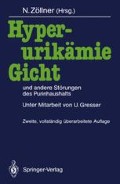Zusammenfassung
Die Inzidenz der Hyperurikämie wurde mit Hilfe von Screeninguntersuchungen der Bevölkerung und der Anwendung automatisierter Analysegeräte untersucht. Es wurde festgestellt, daß es innerhalb der Bevölkerung Individuen gibt, deren Serumharnsäurekonzentration erhöht ist. Die Definition, ab wann man von einer erhöhten Serumharnsäurekonzentration spricht, bietet einige interessante Probleme. Reihenuntersuchungen von normalen Individuen haben gezeigt, daß die Serumharnsäurewerte von Männern und Frauen derselben Verteilung folgen mit einer positiven Verschiebung bei den Männern (Mikkelsen et al. 1965; Hall et al. 1967; Griebsch u. Zöllner 1973). Innerhalb dieser Verteilungen müssen die Werte, welche die Hyperurikämie kennzeichnen, am oberen Ende liegen, und ihre Menge wird von der Festlegung der oberen Normgrenze abhängen. In vielen Fällen wurden die epidemiologischen Daten in Form von Einzelmessungen gesammelt. Die Serumharnsäurekonzentration wird von vielen Faktoren beeinflußt: Männer haben im allgemeinen einen höheren Wert als Frauen. Während der Pubertät steigt die Harnsäurekonzentration bei Männern an und bleibt anschließend konstant, bei Frauen steigt sie mit zunehmendem Alter. Einige Arbeiten (Goldstein et al. 1972) haben jahreszeitliche Schwankungen aufgezeigt. Die Durchschnittskonzentrationen variieren mit der Rasse und anderen genetischen Faktoren, Körperbautyp, sozialer Klasse, Ernährung sowie Umgebung und sind teilweise von der Meßmethode abhängig. Dies alles ist zu berücksichtigen, wenn epidemiologische Daten beurteilt werden.
Übersetzt von I. Kamilli.
Access this chapter
Tax calculation will be finalised at checkout
Purchases are for personal use only
Preview
Unable to display preview. Download preview PDF.
Literatur
Bartels EC (1966) Allopurinol (xanthine oxidase inhibitor in the treatment of gout). J Am Med Ass 198: 708–712.
Bayliss RIS, Clark CA, Whitehead TP, Whitfield AGW (1984) The management of hyperuricaemia. J R Coll Physicians Lond 18: 144–146.
Coe FL (1977) Treated and untreated calcium nephrolithiasis in patients with idiopathic hypercalcuria, hyperuricosuria or no metabolic disorder. Ann Intern Med 87: 404.
Fessel WJ (1979) Renal outcomes of gout and hyperuricemia. Am J Med 67: 74–82.
Goldstein RA, Becker KL, Moor CF (1972) Serum urate in healthy men — intermittent elevations and seasonal effect. N Engl J Med 287: 649–650.
Griebsch A, Zöllner N (1973) Normalwerte der Plasmaharnsäure in Süddeutschland im Vergleich mit Bestimmungen vor zehn Jahren. Z Klin Chem Klin Biochem 11: 348–356.
Gröbner W (1989) „Diet and Drug Treatment of Gout“ In: Wolfram G (ed) Genetic and therapeutic aspects of lipid and purine metabolism. Springer Berlin Heidelberg New York Tokyo, pp 145–154.
Gutman AB (1973) The past four decades of progress in the knowledge of gout with an assessment of the present status. Arthritis Rheum 16: 431–435.
Hall AP, Barry PE, DawberTR, McNamara PM (1967) Epidemiology of gout and hyperuricemia. Am J Med 42: 27–37.
Hart FD (1980) Rheumatic disorders. In: Avery GS (ed) Drug treatment principles and practice of clinical pharmacology and therapeutics, 2nd edn. Edinburgh Harlow New York, Churchill Livingstone, p 878.
Isomaki HA, Takkumen H (1969) Gout and hyperuricaemia in a finnish rural population. Acta Rheumatol Scand 15: 112–120.
Kelley WN (1981) Approach to the patient with hyperuricaemia. In: Kelley WN, Harris ED, Ruddy S, Sledge SB (eds) Textbook of rheumatology. Saunders, Philadelphia London, p 497.
Mikkelsen WM, Dodge HJ, Valkenburg H (1965) The distribution of serum uric acid values in a population unselected as to gout or hyperuricemia. Am J Med 39: 242–251.
Nuki G (1987) „Disorders of purine metabolism“ In: Weatherall DJ, Ledingham JGG, Warrell DA (eds) Oxford Textbook of Medicine, vol 1, 2nd edn. Oxford University Press, Oxford, pp 9123–9135.
Paulus HE, Coutts A, Calabro JJ, Klinenberg JR (1970) Clinical significance of hyperuricemia in routinely screened hospitalized men. JAMA 211: 277–281.
Popert AJ, Hewitt JU (1962) Gout and hyperuricaemia in rural and urban populations. Ann Rheum Dis 21: 154–163.
Prior IAM, Rose BS (1966) Uric acid, gout and public health in the South Pacific. NZ Med J 65: 295–300.
Rosenfeld JB (1974) Effect of long-term Allopurinol administration on serial GFR in normotensive and hypertensive hyperuricaemic subjects. In: Sperling O, de Vries A, Wyngaarden JB (eds) Purine metabolism in man. Plenum Press, New York, pp 581–596.
Rundles RW (1985) The development of allopurinol. Arch Intern Med 145: 1492–1503.
Rundles RW, Metz EN, Silberman HR (1966) Allopurinol in the treatment of gout. Ann Intern Med 64: 229–258.
Scott JT(1980) Long-term management of gout and hyperuricaemia. Br Med J 281: 1164.
Seegmiller JE, Laster L, Howell RR (1963) Biochemistry of uric acid and its relation to gout. N Engl J Med 268: 712–721.
Smith LH (1975) Disorders of purine metabolism. In: Beeson PB, McDermott W (eds): Textbook of medicine, 14th edn. Saunders, Philadelphia London, p 1660.
Woods HF (1986) When to treat hyperuricaemia. Verh Dtsch Inn Med 92: 497–502.
Woods H F (1989) Clinical Aspects of Gout. In: Wolfram G (ed) Genetic and therapeutic aspects of lipid and purine metabolism. Springer Berlin Heidelberg New York Tokyo, pp 137–144.
Wyngaarden RG (1982) Gout. In: Wyngaarden JB, Smith LH (eds) Textbook of medicine, 16th edn. Saunders, Philadelphia, p 1117.
Wyngaarden JB, Kelley WN (1976) Gout and hyperuricaemia. Grune & Stratton, New York San Francisco London, p 461.
Wyngaarden JB, Kelley WN (1983) Definition and significance of hyperuricemia. In: Stanbury JB, Wyngaarden JB, Fredrickson DS, Goldstein JL, Brown MS (eds) The Metabolic Basis of Inherited Disease, 5th edn., McGraw-Hill, New York.
Zalokar J, Lellouch J, Claude JR, Kuntz D (1972) Serum uric acid in 23,923 men and gout in a subsample of 4,257 men in France. J Chronic Dis 25: 305–312.
Editor information
Editors and Affiliations
Rights and permissions
Copyright information
© 1990 Springer-Verlag Berlin Heidelberg
About this chapter
Cite this chapter
Woods, H.F. (1990). Wann behandelt man die Hyperurikämie?. In: Zöllner, N. (eds) Hyperurikämie, Gicht und andere Störungen des Purinhaushalts. Springer, Berlin, Heidelberg. https://doi.org/10.1007/978-3-642-93422-3_15
Download citation
DOI: https://doi.org/10.1007/978-3-642-93422-3_15
Publisher Name: Springer, Berlin, Heidelberg
Print ISBN: 978-3-642-93423-0
Online ISBN: 978-3-642-93422-3
eBook Packages: Springer Book Archive

